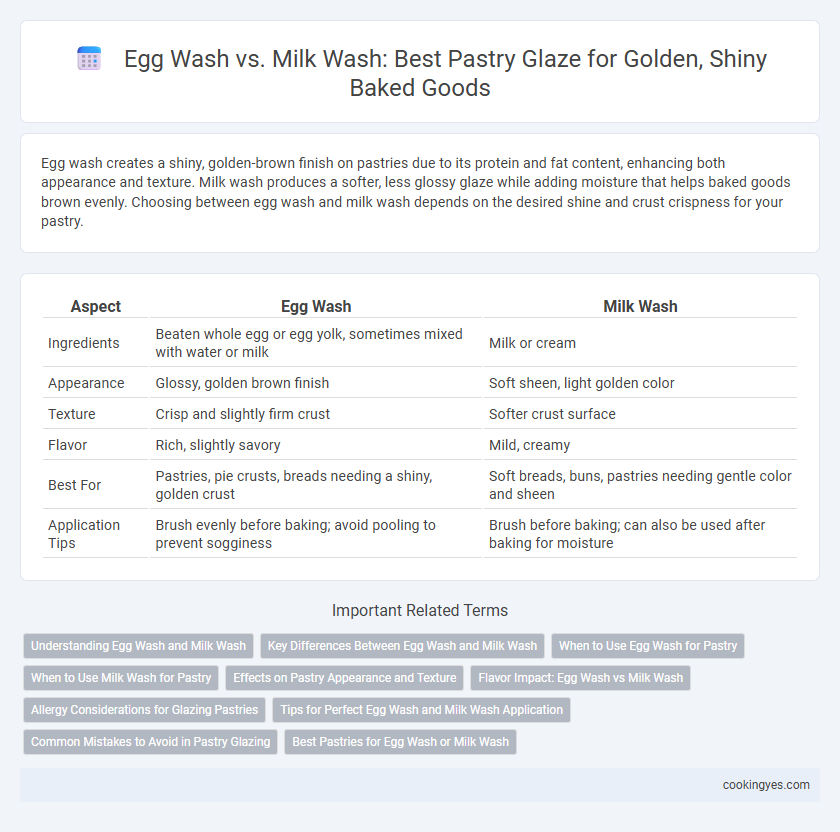Egg wash creates a shiny, golden-brown finish on pastries due to its protein and fat content, enhancing both appearance and texture. Milk wash produces a softer, less glossy glaze while adding moisture that helps baked goods brown evenly. Choosing between egg wash and milk wash depends on the desired shine and crust crispness for your pastry.
Table of Comparison
| Aspect | Egg Wash | Milk Wash |
|---|---|---|
| Ingredients | Beaten whole egg or egg yolk, sometimes mixed with water or milk | Milk or cream |
| Appearance | Glossy, golden brown finish | Soft sheen, light golden color |
| Texture | Crisp and slightly firm crust | Softer crust surface |
| Flavor | Rich, slightly savory | Mild, creamy |
| Best For | Pastries, pie crusts, breads needing a shiny, golden crust | Soft breads, buns, pastries needing gentle color and sheen |
| Application Tips | Brush evenly before baking; avoid pooling to prevent sogginess | Brush before baking; can also be used after baking for moisture |
Understanding Egg Wash and Milk Wash
Egg wash, composed of beaten eggs or egg yolks mixed with water or milk, creates a glossy, rich golden finish on pastries, enhancing both appearance and texture. Milk wash, made from whole milk or cream, imparts a softer sheen and slightly tender crust without the pronounced color or shine of egg wash. Understanding these washes helps bakers choose the ideal glaze to achieve the desired aesthetic and texture for various baked goods.
Key Differences Between Egg Wash and Milk Wash
Egg wash creates a glossy, golden-brown finish due to its protein and fat content, which enhances browning through the Maillard reaction. Milk wash, containing lactose and proteins, produces a softer shine and a slightly tender crust but less intense color compared to egg wash. The choice between egg wash and milk wash affects the pastry's texture, color, and sheen, with egg wash providing a more vibrant, crisp glaze.
When to Use Egg Wash for Pastry
Egg wash is ideal for pastries that require a glossy, golden-brown finish and a slightly crisp texture, such as croissants, pies, and puff pastries. It enhances browning due to its protein content and improves adhesion for toppings like seeds or sugar. Use egg wash when you want a rich color and a shiny, attractive surface on your baked goods.
When to Use Milk Wash for Pastry
Milk wash creates a subtle sheen and promotes gentle browning on pastries without overpowering flavors, making it ideal for delicate doughs like brioche or croissants. It adds moisture and enhances softness, perfect for recipes requiring a tender crumb or a light golden finish. Use milk wash when a mild, glossy appearance is desired without the rich color or firmness that an egg wash provides.
Effects on Pastry Appearance and Texture
Egg wash, composed of beaten eggs often mixed with water or milk, creates a shiny, golden-brown crust on pastries due to its high protein content that promotes browning through the Maillard reaction. Milk wash yields a softer, matte finish with a lighter color and less gloss, as its lactose content caramelizes but lacks the protein-driven browning intensity of eggs. The choice between egg wash and milk wash significantly affects the pastry's visual appeal and surface texture, with egg wash providing a crisp exterior and milk wash resulting in a tender, softer crust.
Flavor Impact: Egg Wash vs Milk Wash
Egg wash creates a rich, golden-brown finish with a slightly savory taste that enhances the pastry's overall flavor profile, while milk wash delivers a softer, subtly sweet glaze that adds moisture without overpowering the dough. The proteins and fats in egg wash contribute to a more pronounced umami flavor, intensifying savory pastries, whereas lactose in milk wash lends a gentle caramelization suited for sweeter baked goods. Choosing between egg wash and milk wash depends on the desired flavor dimension and glossiness, with egg wash favoring depth and milk wash promoting a mild, tender crust.
Allergy Considerations for Glazing Pastries
Egg wash provides a glossy, golden-brown finish to pastries but poses a risk for individuals with egg allergies, potentially causing severe allergic reactions. Milk wash offers a safer alternative for those sensitive to eggs, though it may still trigger dairy allergies and lacks the intense sheen of egg wash. Using plant-based milk washes, such as almond or oat milk, can provide an allergy-friendly glaze option while maintaining moderate browning and shine.
Tips for Perfect Egg Wash and Milk Wash Application
Achieving a flawless pastry glaze involves applying egg wash with a soft pastry brush in gentle, even strokes to prevent pooling and uneven browning. For milk wash, use whole milk for a subtle shine and avoid excessive application to maintain delicate crust texture. Always brush just before baking to ensure optimal gloss and color development on pastries.
Common Mistakes to Avoid in Pastry Glazing
Applying an excessively thick egg wash can cause uneven browning and soggy pastry, while too thin a milk wash may result in a dull finish lacking shine. Avoid using cold washes directly from the refrigerator, as they can hinder proper glazing and cause flakes to separate. Overbrushing can saturate the dough, compromising its texture, so apply only a light, even coat for optimal golden, crisp results.
Best Pastries for Egg Wash or Milk Wash
Egg wash, composed of beaten eggs or egg yolks, creates a glossy, golden-brown finish ideal for savory pastries like pies, quiches, and brioche. Milk wash produces a softer sheen and lighter color, making it suitable for sweet pastries such as scones, cinnamon rolls, and soft dinner rolls. Selecting the right wash enhances both appearance and texture, complementing the specific characteristics of each pastry type.
Egg Wash vs Milk Wash for Pastry Glazing Infographic

 cookingyes.com
cookingyes.com